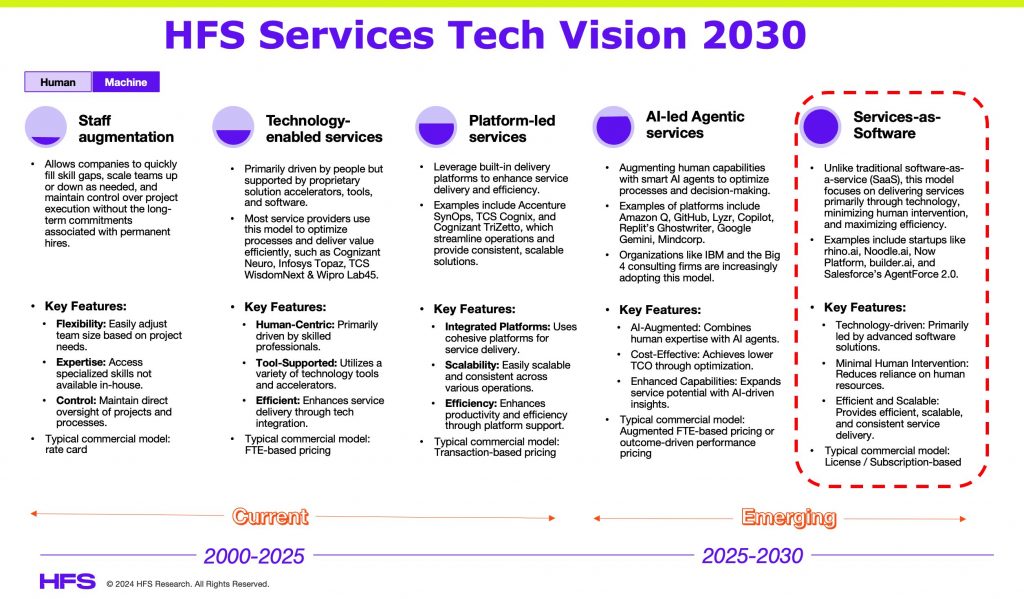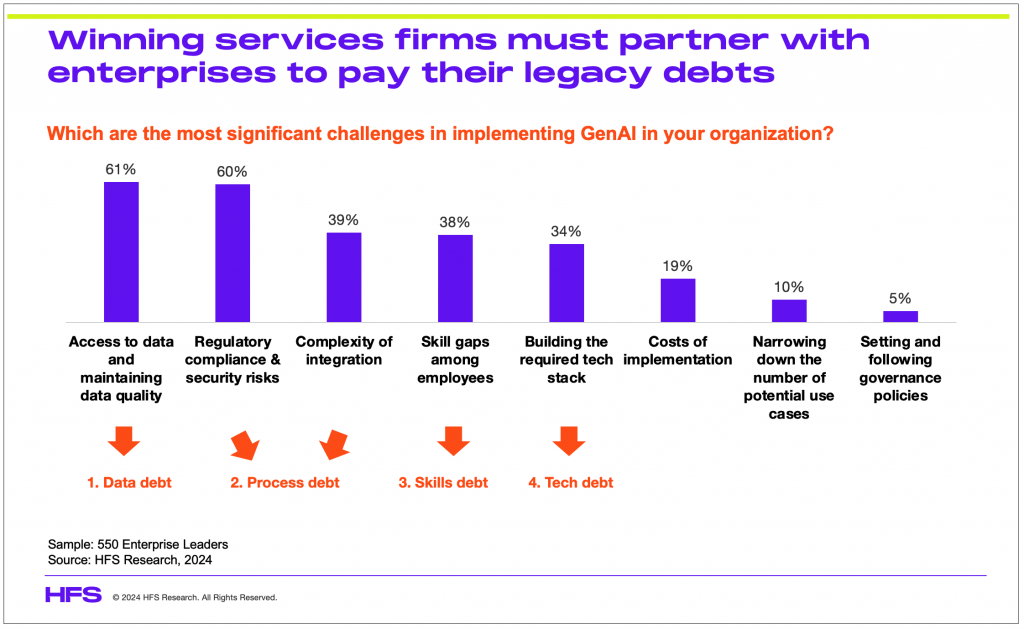Why do enterprises buy services? Because they need “work” performed that can be managed more effectively by people outside of their company. However, by 2030, we will be engaging with “services” primarily through technology, minimizing human intervention and maximizing efficiency. In fact, services will barely even be services anymore…
The future of services is NO services
As the world absorbs the incredible impact of technology and the internet on their businesses, the need for competent third parties to integrate, maintain, and innovate technology has consistently resulted in more and more spend each year. Talk to any CIO or CFO today, and they will bemoan the perpetual annual cycle of more and more money being spent on the cloud, on expensive software licenses, and all the people needed to keep this never-ending thirst for technology slaked.
We must break this death spiral of piling up our legacy debts if we want to stay in business
The problem today is enterprises cannot keep funding this incessant linear growth into perpetuity. They’ve been piling on considerable debt, which is becoming unsustainable as their people become administrators of legacy systems, broken processes, and useless data. Their cultures have become ones of sustaining old business practices and creaking business models, fuelled by a desperate fear of change and having to learn new and different ways of doing things. At HFS, we estimate the technology debt being sustained across the global 2000 to be close to $2 trillion.
And our beloved services industry has profited from this enterprise lethargy and perpetual spending for decades. The practice of piling on kids schooled from Indian universities to document these legacy practices so they can keep delivering them on multiyear contracts, where they can consistently find ways to keep layering on even more people and load yet more cost back onto their jaded enterprise clients, has become an art form. However, this gravy train of constant growth has run its course, with most services firms content with revenue growth that is barely even keeping pace with inflation. The reality is most of the services industry is not ready to retire, and we urgently need to innovate service provision to stay relevant in this game.
It’s all about scaling businesses with technology that enhances our existing people
The need to scale services without scaling people is upon us, and with it comes a massive opportunity if both ambitious enterprises and service providers are prepared to change how they buy and sell routine services and professional expertise. With the application of software platforms, agentic solutions, and, ultimately, autonomous services mimicked by software, we believe we are on a fast track to reach an autonomous, human-lite nirvana of scalable, profitable, secure and affordable services by 2030:

These five phases of services tell the complete story of the industry’s evolution from adding people to perform work to scaling these same people with the smart use of platforms, AI-driven agentic tools, and ultimately fully autonomous technology-led services where work is effectively replicated at scale with embedded intelligence.
The 2030 destination is Service-as-a-Software, where the focus is on service provision, which doesn’t really involve services anymore
In short, we are getting more of the same work without having to spend more on that same work. Instead, we can invest that money in value-added areas that cannot be mimicked by AI. Enterprises must adapt quickly to this shift as agentic AI can autonomously handle complex decision-making tasks. This will impact both workforce roles and the enterprise software landscape, reducing the need for repetitive, decision-heavy positions and consolidating software functions under AI-driven platforms.
As this landscape continues to evolve with more major players launching agentic solutions, ambitious startups such as Mindcorp.ai, rhino.ai, Daybreak and Lyzr will differentiate by offering unique capabilities, ensuring cross-platform compatibility, and demonstrating cost-saving benefits to appeal to enterprise clients. These emerging solutions are forcing the breakaway from legacy technologies and the reinvention of business models to take full advantage.
Net-net, the impact on services, as demonstrated above, is an increasing reliance on machines to fulfill the complex tasks previously delivered by people. We are eventually heading towards Service-as-a-Software, where the focus will be on outcome provision, which doesn’t really involve traditional services anymore. Instead, we will be delivering “services” primarily through technology, minimizing human intervention and maximizing efficiency.
Writing off legacy means partnering for change
Ambitious enterprises and their service partners are both striving to be effective in the emerging world of these AI-driven business models and operations. This means this transition only works when there are two parties ready to tango and change together. To this end, service providers must become partners of change for their clients to help them understand the sheer noise of technology change going on around them. Clients need internal alignment to ensure that it’s time to make the move.
The shift from labor to technology doesn’t take away the need for people; it actually necessitates experts who can shepherd their clients along to help them change. They must provide continuous education on how to manage organizations’ fast-moving technology ecosystems and work with them to create business roadmaps based on emerging tech to make them slicker, smarter, more efficient, and less bloated.
Enterprises are buying service solutions that improve performance, accelerate time to market, reduce costs, and create new content and data. We must address our debt across our entire data infrastructure, our processes, our skills and our tech, which our firm has likely collected over the last 30+ years:
1. Fix your data debts: You must align your data needs to deliver on your AI-centric business strategy. This is where you clarify your vision and purpose. Do you know what your customers’ needs are? Is your supply chain effective in sensing and responding to these needs? Can your cash flow support immediate critical investments? Do you have a handle on your staff attrition?
2. Fix your process-debts: Recreate new processes process to determine what should be added, eliminated, or simplified across your workflows to support your slicker AI-led operating model.
3. Fix your skills debts: Develop new skill sets that can support the transition to embracing emerging technology and AI-driven business models.
4. Fix your technology debts: IT spending just keeps increasing and only keeps swelling with each new platform and coding change. Stop buying tech for the sake of tech—this has been the failure of so many previous investments, such as the two-thirds of enterprises left struggling with their cloud migration journeys signed during the pandemic.
The Bottom-line: Enterprises can only repay their debts by adopting a technology-first approach
Enterprise leadership has always been – and still is – obsessed with cost reduction. This is what they understand more than anything, and they view innovations such as GenAI as another lever to justify investments based on yet more cost take-out. The best approach is to reduce overall delivery costs by investing in change and technology that can scale services. This is offset by the increased value and reduced labor costs driven through effective investments in change, processes, data, and technology. Clients MUST sign up for process reinvention and data transformation as part of it. Clients need to TRUST their partners to get them there. Providers need the TALENT to work with their customers, or the whole thing simply erodes to the bottom.
What enterprises desperately need are partners to work with them who share similar desires to learn new methods, unlearn old habits, and to teach them to exploit new technologies and new data methodologies and work with them to attack new markets with these capabilities.
The big question now is whether enterprises and their services partners have the appetite to fix their skills, processes, data, and technical debt? Can they really learn new ways of operating, change their cultures, and embrace emerging technologies? Everyone needs to dig deep and decide whether they want to be a footnote or the future.
Posted in : Agentic AI, Analytics and Big Data, Artificial Intelligence, Automation, Business Process Outsourcing (BPO), Buyers' Sourcing Best Practices, ChatGPT, Cloud, Digital OneOffice, Digital Transformation, GenAI, Generative Enterprise, Global Business Services, Industry Cloud, Services-as-Software, Sourcing Best Practises








Services as software can also mean productised services, which is a combination of people and platforms
Do we have a five year business case and ROI for this shift to service as a software. I am particularly interested since I am from India which is one of the largest service exporters today. A probable pricing model for this offering on a bundled basis consisting of technology costs, manpower costs etc will be pitted against the current cost model to arrive at the five year ROI.
Please send it to my email id if available.